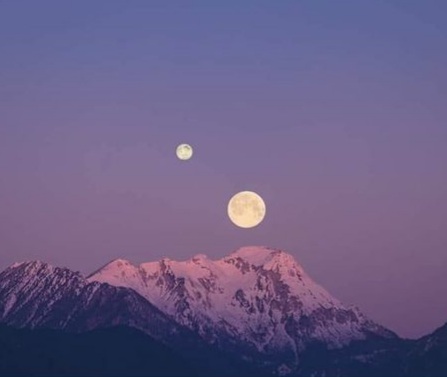Second moon will be visible in the sky from September 29, know where this mini moon comes from…
On September 29, a smaller moon will become another moon revolving around the Earth. Know where it is coming from and where it is going. How long will Earth's moon last?
It has also been called a mini moon, it was named 2024 PT511. A mini moon had come in the Earth's orbit even years ago. It will definitely revolve around the world but will not be visible with the naked eye. You already know about one of the Earth's moons. But now the Earth is going to get a second moon. It is also being called mini moon because of its size. This new moon of the Earth will be found next month but it will not last long. Then he will find his new path. The second moon will be seen hardly after four days. Some people are calling this new moon as mini moon. However, astronomers have named it 2024 PT5. Actually, it was not in the Earth's orbit till now, but the Earth's gravity has almost succeeded in pulling it towards itself.
Just as people are drawn towards hypnosis, at this time it is being drawn towards the Earth. From September 29, it will start revolving around the world and then will remain with the Earth for about two months. Then on 25th November it will say Tata-bye-bye to us.
What will be its size? Astronomers first saw it coming towards the Earth on August 7 at the Observatory in South Africa. This is such a small moon, which is also being called an asteroid and asteroid. It is known as “Arjun Asteroid”. Its size is said to be equal to a big room i.e. around 11 meters or 37 feet. It will be like a horseshoe. However, its full size will be known only when it joins the Earth's family and starts roaming. After this it will return to the Sun's orbit, which is called heliocentric orbit.
What happened to the Moon found in 2013? Asteroid is also called space rock. Similarly, Earth got one such moon in the year 2013. It was about 55 to 65 feet (17 to 20 meters) in size. This asteroid exploded in the air. This released 20 to 30 times more energy than the atomic bomb dropped on Hiroshima, Japan. It produced more brightness than the sun. Its debris damaged more than 7,000 buildings and injured more than 1,000 people. However, there is no danger of colliding with this small moon. It will orbit the Earth at a distance of 2.6 million miles (4.2 million kilometers). Generally two types of asteroids come in the Earth's orbit. One that makes several revolutions around the planet and lives for many years. There are others which do not even complete a complete revolution around the Earth.
Earth's gravity often pulls small asteroids into its orbit. This causes them to temporarily become “mini-moons”. Researchers have called this mini-moon a “flyby”. Why it cannot be seen with the naked eye? We cannot see this mini-moon because its brightness is magnitude 22, which makes it visible with the naked eye or It makes it impossible to see even with the powerful telescopes available in the market. It can only be seen with a large 30-inch professional telescope.
Where do such mini moons come from? Mini-moons can also be asteroids that come from the main asteroid belt located between Mars and Jupiter. Mini Moon i.e. 2024 PT5 will leave Earth's orbit after some time, but astronomers hope that it will become Earth's small moon for a few days in November 2055 and again for a few weeks in early 2084. Universidad Complutense de Madrid researchers Dr. Carlos de la Fuente Marcos and Dr. Raul de la Fuente Marcos wrote in their paper, “Earth may regularly capture asteroids from the near-Earth object (NEO) population. This can pull them into orbit, causing them to become small moons.
It will have no impact Due to its small size, this mini-moon is predicted not to cause any observable impact or be considered a threat to us. Moreover, due to its size, it will not affect the tides. This is not the first time this is happening. Interestingly, researchers also pointed out that this is not the first time that the Earth has two moons. This event was observed in 1981 and 2022 with asteroid 2022 NX1, which will appear again in 2051.
Post Views: 385


Comments are closed.